Samsung Electronics Co HLK506W 61-inch LCD Projection TV Monitor User Manual part1
Samsung Electronics Co Ltd 61-inch LCD Projection TV Monitor Users Manual part1
Contents
- 1. Users Manual part1
- 2. Users Manual part2
Users Manual part1

INSTRUCTION MANUAL
Projection Color Television HLK436W/HLK506W
SAMSUNG ELECTRONICS AMERICA INC.
105 CHALLENGER ROAD, RIDGEFIELD PARK, NJ 07660 U.S.A.
FOR YOUR NEAREST SAMSUNG SERVICE CENTER
DIAL 1-800-SAMSUNG
www.samsungusa.com
AA68-01242A(ENG)

Safety Instructions Table of Contents
2 3
Warning! Important
Safety Instructions
CAUTION: TO REDUCE THE RISK OF ELECTRIC SHOCK, DO NOT REMOVE COVER (OR
BACK). THERE ARE NO USER SERVICEABLE PARTS INSIDE. REFER ALL SERVICING TO QUALI-
FIED SERVICE PERSONNEL.
This symbol indicates high voltage is present. It is dangerous to make any
kind of contact with any part inside this product.
This symbol alerts you that important literature concerning operation and
maintenance has been included with this product.
CAUTION: FCC/CSA regulations state that any unauthorized changes or modifications to this
equipment may void the user’s authority to operate it.
CAUTION: To prevent electric shock, match the wide blade of plug to the wide slot, and fully
insert the plug.
ATTENTION: Pour eviter les chocs electriques, introduire la lame le plus large de la fiche dans
la borne correspondante de la prise et pousser jusqu’au fond.
Note to CATV system installer: This reminder is provided to call CATV system installer’s attention
to Article 820-40 of the National Electrical Code (Section 54 of Canadian
Electrical Code, Part I), that provides guidelines for proper grounding and, in particular, speci-
fies that the cable ground shall be connected to the grounding system of the building as close to
the point of cable entry as possible.
Important: One Federal Court has held that unauthorized recording of copyrighted TV programs
is an infringement of U.S. copyright laws. Certain Canadian programs may also be copyright-
ed and any unauthorized recording in whole or in part may be in violation of these laws.
To prevent damage which may result in fire or electric shock,
do not expose this appliance to rain or moisture.
Introduction................................................................................................6
Your New Wide TV ..................................................................................10
List of Features ........................................................................................................10
Checking Parts ........................................................................................................10
Side Panel Buttons ..................................................................................................11
Side Panel Jacks......................................................................................................11
Side Panel LED Indicators ........................................................................................12
Rear Panel Jacks......................................................................................................13
Remote Control........................................................................................................14
Connections ............................................................................................18
Connecting VHF and UHF Antennas ..........................................................................18
Antennas with 300-ohm Flat Twin Leads............................................................18
Antennas with 75-ohm Round Leads ................................................................18
Separate VHF and UHF Antennas ....................................................................19
Connecting Cable TV and VCR ................................................................................20
Cable without a Cable box..............................................................................20
Cable with a Cable Box that Descrambles All Channels......................................20
Connecting a Cable Converter Box ..................................................................21
Connecting a Cable Converter Box and a VCR..................................................21
Connecting a Camcorder..........................................................................................22
Connecting a DVD Player ........................................................................................23
Connecting a Set Top Box ........................................................................................24
Connecting Surround Speakers..................................................................................25
Operation .............................................................................................. 28
Turning the TV On and Off ......................................................................................28
Adjusting Basic Convergence....................................................................................28
Viewing the Menus and Displays ..............................................................................30
Displaying the Menus......................................................................................30
Displaying Status Information ..........................................................................30
Selecting the Menu Language ..................................................................................31
Selecting the Antenna Input ......................................................................................31
Channel Memory ....................................................................................................32
Selecting the Broadcast Source ........................................................................32
Storing Channels in Memory Automatically ......................................................33
Adding and Erasing Channels ........................................................................33
Changing Channels ................................................................................................34
Using the Channel Buttons ..............................................................................34
Using the Number Buttons ..............................................................................34
Using the Previous Channel ............................................................................34
Scanning channels..........................................................................................34
Selecting Your Favorite Channels ..............................................................................35
To Store Your Favorite Channels ......................................................................35
To View Your Favorite Channels ......................................................................35
As an ENERGY STAR Partner,
Samsung Electronics America, Inc. has determined that this product or product model meets the ENERGY
STAR guidelines for energy efficiency.

Table of Contents Table of Contents
4 5
Operation (Continued)
Sound Control ........................................................................................................36
Adjusting the Volume ......................................................................................36
Using the Mute Button ....................................................................................36
Customizing the Sound....................................................................................36
Using Automatic(Standard) Sound Settings ........................................................37
Picture Control ........................................................................................................38
Customizing the Picture ..................................................................................38
Using Automatic (“Standard”) Picture Settings....................................................39
Setting the Clock ............................................................................................40
Setting the Timers ....................................................................................................41
Setting the On/Off Timer ................................................................................41
Setting the Sleep Timer....................................................................................42
Setting Up Your Remote Control ................................................................................43
Setting Up the Remote to Operate Your VCR......................................................43
Setting Up the Remote to Operate Your Cable Box ............................................44
Setting Up the Remote to Operate Your DVD......................................................45
Remote Control Codes..............................................................................................46
Viewing a VCR, DVD or Camcorder Tape ..................................................................47
Selecting the Signal Source..............................................................................47
Remote Control VCR Buttons....................................................................47
Special Features ...................................................................................... 50
Special Video Features ............................................................................................50
Fine Tuning Channels......................................................................................50
Special Audio Options: Dolby Surround, MTS ............................................................51
Dolby Pro Logic..............................................................................................51
MTS Settings: Choosing a Soundtrack ..............................................................53
Viewing Closed Caption Information..........................................................................54
Changing the Screen Size ........................................................................................55
Viewing Picture-in-Picture ........................................................................................ 56
Selecting a PIP Screen ....................................................................................56
Selecting an External Signal ............................................................................57
Changing the Picture-in-Picture Channel ............................................................58
Swapping the Contents of the PIP image and Main image ..................................59
Changing the Location of the PIP image............................................................59
Changing the Size of the PIP image..................................................................59
Using the V-Chip......................................................................................................60
Setting Up Your Personal ID Number (PIN) ........................................................60
How to Enable/Disable the V-Chip ..................................................................61
How to Set up Restrictions Using the “TV guidelines”..........................................61
How to Set up Restrictions Using the MPAA Ratings:G, PG, PG-13, R, NC-17, X ..63
How to Reset the TV after the V-Chip Blocks a Channel (“Emergency Escape”) ....64
PC Display.............................................................................................. 66
Using Your TV as a Computer (PC) Display ................................................................66
How to Connect Your PC to the TV ..................................................................66
How to Set up Your PC Software (Windows only) ..............................................67
Changing the Position of the Image (Moving left, right, up and down)..................69
Changing the Size of the Image ......................................................................70
Picture Quality Adjustment ..............................................................................71
Screen Adjustment in PC mode ........................................................................72
Selecting Sound Source in PC Mode ................................................................73
Appendix ................................................................................................76
Troubleshooting ......................................................................................................76
Care and Maintenance .......................................................................................... 77
Using the TV in Another Country .............................................................................. 77
Specifications..........................................................................................................77
Rear Panel Air Vent..................................................................................................78

• Protect the power cord. Power supply cords should be routed so that they won’t be walked on or
pinched by objects placed on or against them. Pay particular attention to cords at plugs, conve-
nience receptacles, and the point where they exit from the unit.
• Unplug the TV from the wall outlet and disconnect the antenna or cable system during a lightning
storm or when left unattended and unused for long periods of time. This will prevent damage to the
unit from lightning and power-line surges.
• Avoid overhead power lines. An outside antenna system should not be placed in the vicinity of over-
head power lines or other electric light or power circuits, or where it can fall into such power lines or
circuits. When installing an outside antenna system, be extremely careful to keep from touching the
power lines or circuits. Contact with such lines can be fatal.
• Do not overload the wall outlet or extension cords. Overloading can result in fire or electric shock.
• Do not insert anything through the openings in the unit, where they can touch dangerous voltage
points or damage parts. Never spill liquid of any kind on the TV.
• Ground outdoor antennas. If an outside antenna or cable
system is connected to the TV, be sure the antenna or cable sys-
tem is grounded so as to provide some protection against volt-
age surges and built-up static charges. Section 810 of the
National Electrical Code, ANSI/NFPA No.70-1984, provides
information about proper grounding of the mast and
supporting structure, grounding of the lead-in wire to an anten-
na discharge unit, size of grounding conductors,
location of antenna discharge unit, connection to grounding
electrodes, and requirements for the grounding electrode.
• Do not attempt to service the TV yourself. Refer all servicing to qualified service personnel.
Unplug the unit from the wall outlet and refer servicing to qualified service personnel when:
- The power-supply cord or plug is damaged
- Liquid has been spilled on the unit or if objects have fallen into the unit
- The TV has been exposed to rain or water
- The TV does not operate normally by following the operating instructions
- The TV has been dropped or the cabinet has been damaged
- The TV exhibits a distinct degradation in performance
- When the LAMP(BULB ONLY) replacement is needed
• If you make adjustments yourself, adjust only those controls that are covered by the operating instruc-
tions. Adjusting other controls may result in damage and will often require extensive work by a quali-
fied technician to restore the TV to normal.
• When replacement parts are required, be sure the service technician uses replacement parts speci-
fied by the manufacturer or those that have the same characteristics as the original part.
Unauthorized substitutions may result in additional damage to the unit.
• Upon completion of any service or repairs to this TV, ask the service technician to
perform safety checks to determine that the TV is in a safe operating condition.
This device complies with part 15 of the FCC Rules. Operation is subject to the following two
conditions:
(1) This device may not cause harmful interference, and
(2) This device must accept any interference that may cause undesired operation.
This television receiver provides display of television closed captioning in accordance with §15.119 of
the FCC rules.
Introduction Introduction
6 7
Thank You for Choosing Samsung
Thank you for choosing Samsung! Your new Samsung projection TV represents the latest in television
technology. We designed it with easy-to-use on-screen menus and closed captioning capabilities,
making it one of the best products in its class. We are proud to offer you a product that will provide
convenient, dependable service and enjoyment for years to come.
Important Safety Information
Always be careful when using your TV. To reduce the risk of fire, electrical shock, and other
injuries, keep these safety precautions in mind when installing, using, and maintaining your
unit.
• Read all safety and operating instructions before operating your TV.
• Keep the safety and operating instructions for future reference.
• Heed all warnings on the TV and in the operating instructions.
• Unplug the TV from the wall outlet before cleaning. Use a damp cloth; do not use liquid or
aerosol cleaners.
• Never add any attachments and/or equipment without approval of the manufacturer. Such
additions can increase the risk of fire, electric shock, or other personal injury.
• Do not use the TV where contact with water is possible, such as near bath tubs, sinks, washing
machines, swimming pools, etc.
• Do not place the TV on an unstable cart, stand, tripod, bracket, or table
where it can fall. A falling TV can cause serious injury to a child or adult,
and serious damage to the appliance. Use only with a cart, stand, tripod,
bracket, or table recommended by the manufacturer or sold with the TV.
Follow the manufacturer’s instructions when mounting the unit, and use a
mounting accessory recommended by the manufacturer. Move the TV and
cart with care. Quick stops, excessive force, and uneven surfaces can
make the unit and cart unsteady and more likely to overturn.
• The TV is designed with slots in the cabinet for ventilation to protect it from overheating. Do not
block these openings with any object, and do not put the TV on a bed, sofa, rug, or other similar
surface. Do not put the TV near a radiator or heat register. If you do put the TV on a rack or
bookcase, make sure that there is adequate ventilation and that you’ve followed the manufacturer’s
instructions for mounting.
• Operate your TV only from the type of power source indicated on the marking label. If you are not
sure of the type of power supplied to your home, consult your appliance dealer or local power
company.
• Use only a grounded or polarized outlet. For your safety, this TV is equipped with a polarized alter-
nating current line plug having one blade wider than the other. This plug will fit into the power out-
let only one way. If you are unable to insert the plug fully into the outlet, try reversing the plug. If
the plug still does not fit, contact an electrician to replace your outlet.

Your New Wide TV
SAMSUNG
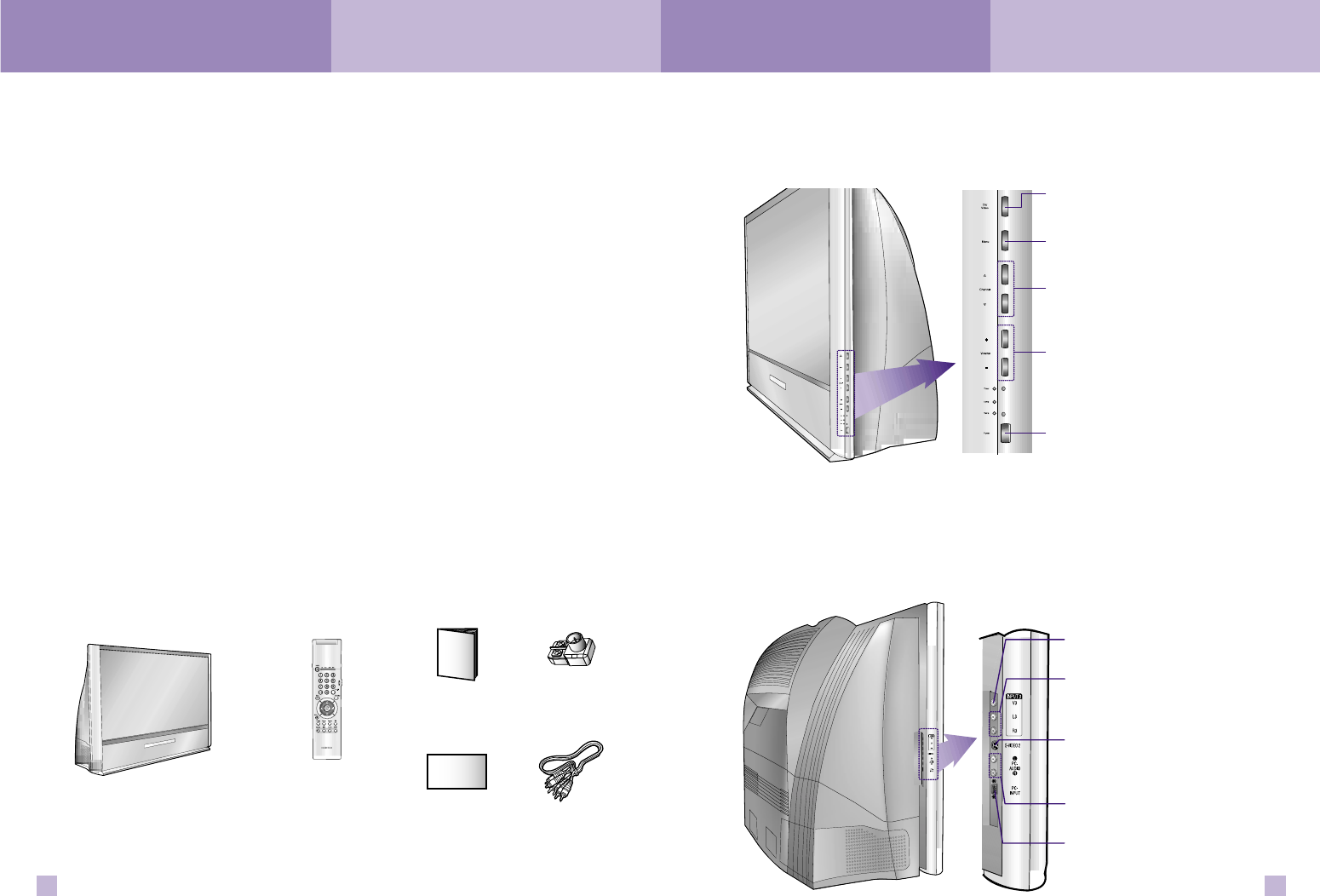
Your New Wide TV Your New Wide TV
10 11
List of Features
Your Samsung TV was designed and engineered using the latest technology. It is a full-featured,
high-performance unit that exceeds industry standards. In addition, it has these special features:
• Easy-to-operate remote control
• Easy-to-use on-screen menu system you can access from the side panel or remote control
• Automatic timer to turn the TV on and off at any time you choose
• Adjustable picture and sound settings and the ability to memorize your favorite settings
• Automatic channel tuning for up to 181 channels
• Fine tuning control for the sharpest picture possible
• A built-in multi-channel sound decoder for stereo and bilingual listening
• Built-in, dual channel speakers (15 watts per channel)
• Picture-in-Picture capability that lets you watch two channels at once
• Widescreen TV with adjustable image size
• COMPONENT INPUT jacks to obtain a sharper image from external sources
• PC input
• Surround output
• HD COMPONENT input
Checking Parts
Once you have unpacked your TV, check to make sure that you have all the parts shown here.
If any piece is missing or broken, call your dealer.
(The TV illustration shown does not necessary match the design of your TV set.)
300-75 ohm
Adapter
This
Manual
Television Wireless Remote
Control Warranty
Card RCA Cable
Side Panel Buttons
The buttons on the side panel control your TV’s basic features, including the on-screen menu
system. To use the more advanced features, you must use the remote control.
Side Panel Jacks
Use the side panel jacks to connect a component that is used only occasionally (a camcorder,
video game or PC, for example).
Menu
Press to see the on-screen menu.
▲Channel ▼
Press to change channels.
Volume +, –
Press to lower or raise the volume.
Power
Press to turn the TV on and off.
VIDEO IN JACK
Connect the video signal from a camcorder or video game.
AUDIO IN JACKS
Connect the audio signal from a camcorder or video game.
S-VIDEO IN JACK
Connect an S-video signal from a camcorder or video game.
(S-Video 2 jack and Audio L/R input 3 interlock.)
PC AUDIO IN JACKS
Connect these to the audio-output jacks on your PC.
PC VIDEO IN JACK
Connect to the video output port on your PC.
TV/Video
Press to display all of the available video sources (i.e., TV, VCR,
DVD, DTV, PC.).
• To select an external source signal with the TV/Video button on the side panel,
(1) press the TV/Video button, (2) use the channel up/down buttons to move to
source signal that you prefer, and (3) press the volume +/- buttons to select it.
(Note: To select an external source signal with the TV/Video button on the
remote control, use the joystick button to select the source signal that you pre-
fer.)
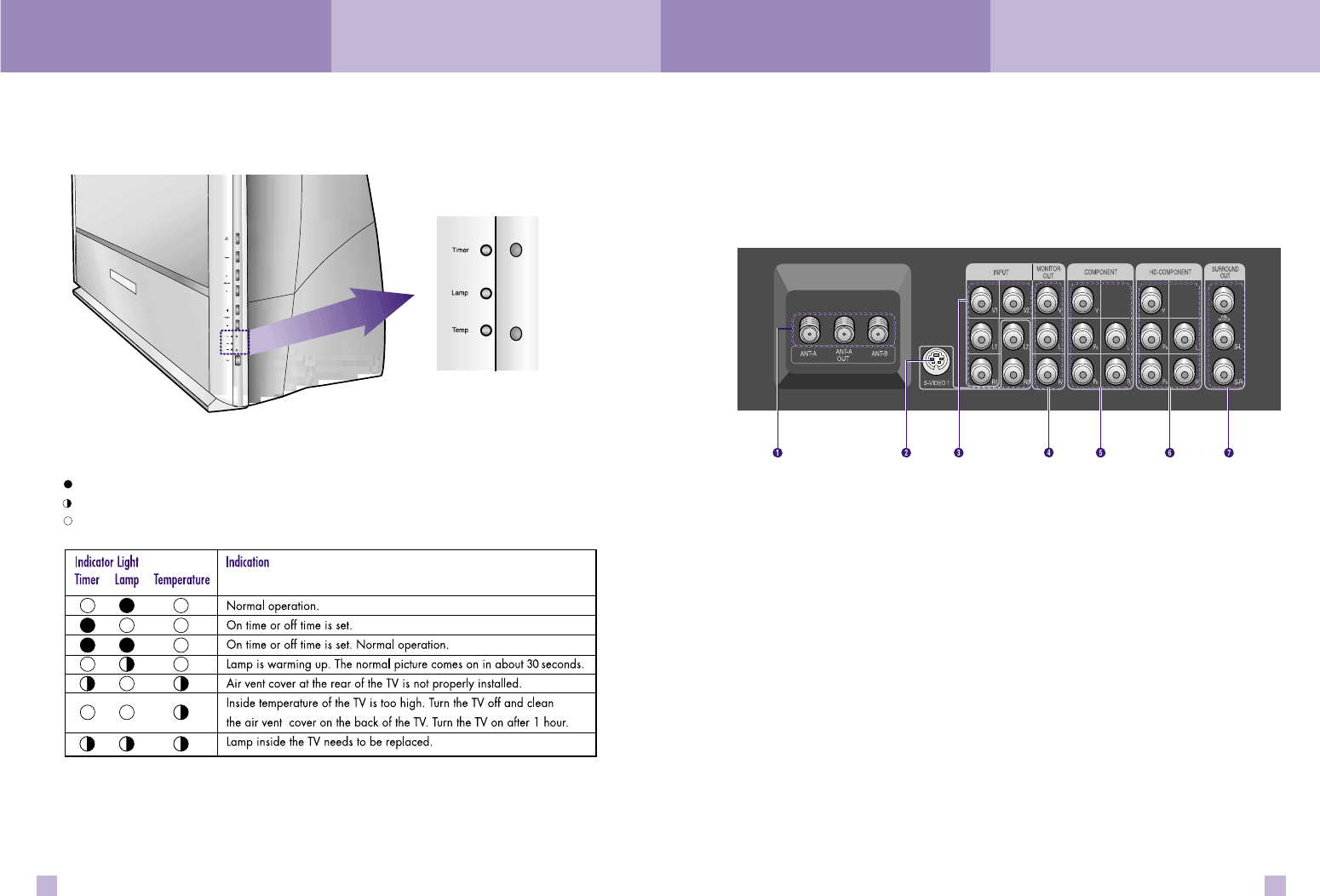
Your New Wide TV Your New Wide TV
12 13
Side Panel LED Indicators
The three lights on the side panel indicate the status of your TV.
Indicator Light Key
• It takes about 30 seconds for the TV to warm up, so normal brightness may not appear
immediately.
• The TV has a fan to keep the inside lamp from overheating. You’ll occasionally hear it
working.
: Light is On
: Light is Blinking
: Light is Off
Rear Panel Jacks
Use the rear panel jacks to connect components such as a VCR or laserdisc player.
You can connect two different components such as two VCRs, a laserdisc player and a DVD play-
er etc., because there are two sets of video input jacks and one set of component video input
jacks on the rear panel of your TV. For more information, please see “Connections”.
Œ
ANTENNA terminals
Two independent cables or antennas can be connected to these termi-
nals. Use ANT-A and ANT-B terminals to receive a signal from
VHF/UHF antennas or your cable system. Use the ANT-A OUT termi-
nal to send the signal being received by the ANT-A terminal out to
another component (such as a Cable Set Top Box).
The PIP channel can be received only when a signal source is
connected to ANT-A.
´
S-VIDEO IN jack
Connects an S-Video signal from an S-VHS VCR or laserdisc player.
ˇ
VIDEO INPUT jacks(V1, V2)
Connect video signals from external sources like VCRs or DVD play-
ers.
AUDIO INPUT jacks(L1,R1/L2,R2)
Connect audio signals from external sources like VCRs or DVD play-
ers.
¨
VIDEO MONITOR OUT jack
Sends a video signal from the TV to an external source, such as a
VCR.
AUDIO MONITOR OUT jacks
Send audio signals from the TV to an external source, such as a VCR.
ˆ
COMPONENT AUDIO INPUT jacks (L, R)
Use these jacks to connect the audio signals from a DVD player when
using the component video input jacks.
COMPONENT VIDEO INPUT jacks (Y, PB, PR)
Use these jacks to connect the component video signals from
a DVD player.
Note: Only 480i format is supported in its original format.
Ø
HD Component (set top) VIDEO INPUT jacks
(Y, PB, PR)
Receives the DTV video signals (Y/PB/PR) from a set top box.
Note: Only 480p, 720p and 1080i formats are supported in their
original formats.
HD Component (set top) AUDIO INPUT jacks
(L, R)
Receives the DTV audio signals (L/R) from a set top box.
∏
SURROUND OUTPUT jacks
Use to connect a subwoofer and powered rear surround speakers.
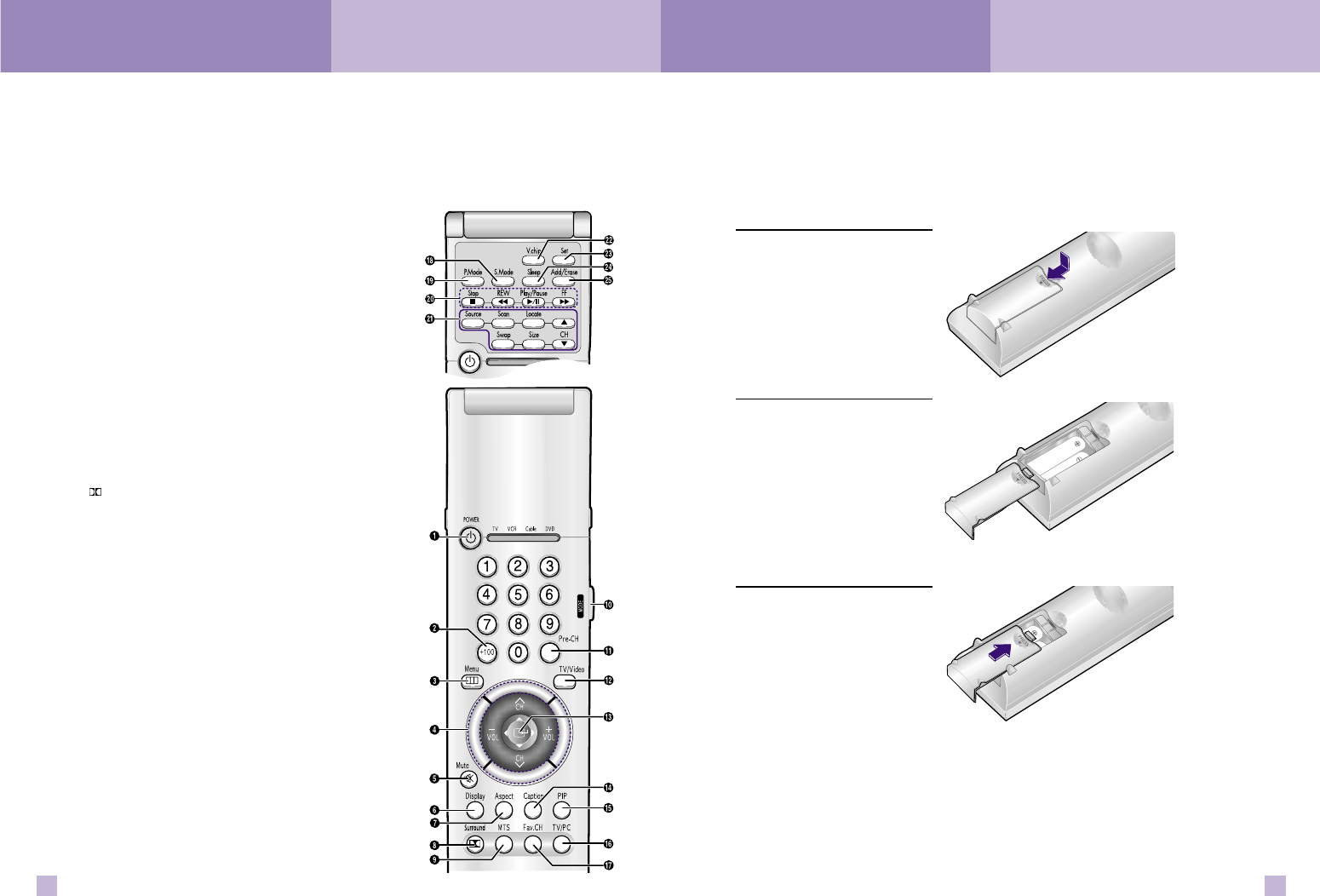
Your New Wide TV Your New Wide TV
14 15
Remote Control
You can use the remote control up to a distance of about 23 feet from the TV. When using the
remote, always point it directly at the TV. The remote control can also operate your VCR, cable box,
and DVD player.
Installing Batteries in the Remote Control
With normal use, the batteries in the remote control should last about a year. If you notice a perfor-
mance degradation while using the remote, the batteries may need to be replaced. Make sure you
replace both batteries and do not mix old and new batteries in the remote control. If you won’t be
using the remote control for a long time, remove the batteries and store them in a cool dry place.
1Slide the back cover all the
way out to open the battery
compartment of the remote
control.
2Install two AAA size
batteries. Make sure to
match the “+” and “–” ends
of the batteries with the
diagram inside the compart-
ment.
3Slide the cover back into
place.
1. POWER
Turns the TV on and off.
2. +100
Press to select cable channels over 100 on
TV.
3. Menu
Displays the main on-screen menu.
4. CH(Channel) and
VOL(Volume)
Controls volume, channel selection.
5. Mute
Press to mute the TV sound.
6. Display
Press to display information on the TV
screen.
7. Aspect
Press to change the screen size.
8. Surround
Press to hear the Dolby surround effect.
9. MTS(Multichannel
Television Stereo)
Press to choose stereo, mono or Separate
Audio Program (SAP broadcast).
10. Mode
Selects a target device to be controlled by
the Samsung remote control (i.e., TV, VCR,
Cable, or DVD).
11. Pre-ch
Tunes to the previous channel.
12. TV/Video
Press to display all of the available video
sources (i.e., TV, VCR, DVD, DTV, PC).
13. Joystick
Use to highlight on-screen menu items and
change menu values.
14. Caption
Controls the caption decoder.
15. PIP
Activates picture in picture.
16. TV/PC
Press to switch to the PC mode (when the
PC is connected to your TV).
17. Fav.CH (Favorite
Channel)
Press to switch between your favorite chan-
nels.
18. S.Mode
Adjust the TV sound by selecting one of the
preset factory settings (or select your per-
sonal, customized sound settings.)
19. P.Mode
Adjust the TV picture by selecting one of the
preset factory settings (or select your per-
sonal, customized picture settings.)
20. VCR controls
Controls VCR tape functions: Rewind, Play,
Fast Forward, Stop, Pause.
21. PIP controls
Source ; Press to select one of the available
signal sources for the PIP window.
Scan; Press to scan the memorized
channels.
Locate; Press to move the PIP window to
any of the four corners of the TV screen.
Swap; Exchanges the video signal that is
currently displayed on the main screen with
the signal in the PIP window.
Size; Press to make the PIP window larger
or smaller.
CH(PIP); Displays the available channels in
sequence. (These buttons change channels
in the PIP window only.)
22. V.chip
Press to set up and activate the parental
locks.
23. Set
Used during set up of this remote control,
so that it will work compatibly with other
devices (VCR, cable box, DVD, etc.)
24. Sleep
Press to select a preset time interval for
automatic shutoff.
25. Add/Erase
Press to add or erase channels in the TV’s
memory.
Use the Add/Erase button to
memorize/erase the optimal state of value
after fine tuning channels.

Connection
SAMSUNG
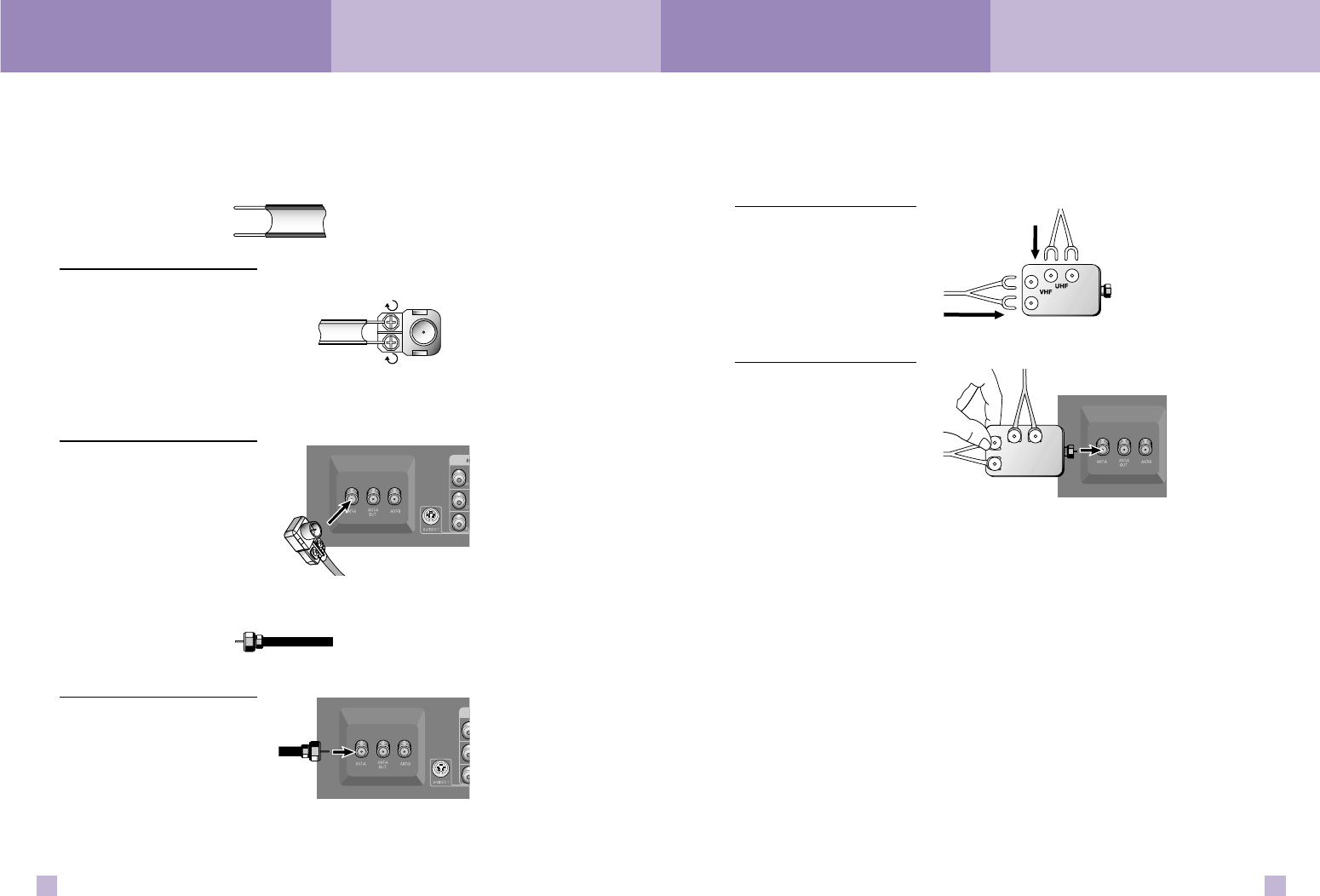
Separate VHF and UHF Antennas
If you have two separate antennas for your TV (one VHF and one UHF), you must combine the
two antenna signals before connecting them to the TV. This requires a combiner attachment, which
you can buy at an electronics store.
1Connect both antenna
leads to the combiner.
2Plug the combiner into the
ANT A terminal on the
back panel of the TV.
Connections Connections
18 19
Connecting VHF and UHF Antennas
If you do not have a cable system, you will need to connect an antenna to your TV.
Antennas with 300-ohm Flat Twin Leads
If your antenna looks like this: it has 300-ohm flat twin leads.
1Place the wires from the twin
leads under the screws on the
300-75 ohm adapter (includ-
ed). Use a screwdriver to
tighten the screws.
2Plug the adapter into the
ANT A terminal on the back
panel of the TV.
Antennas with 75-ohm Round Leads
If your antenna looks like this: it is an antenna with 75-ohm round leads.
1Plug the antenna lead into the
ANT A terminal on the back
panel of the TV.
VHF UHF
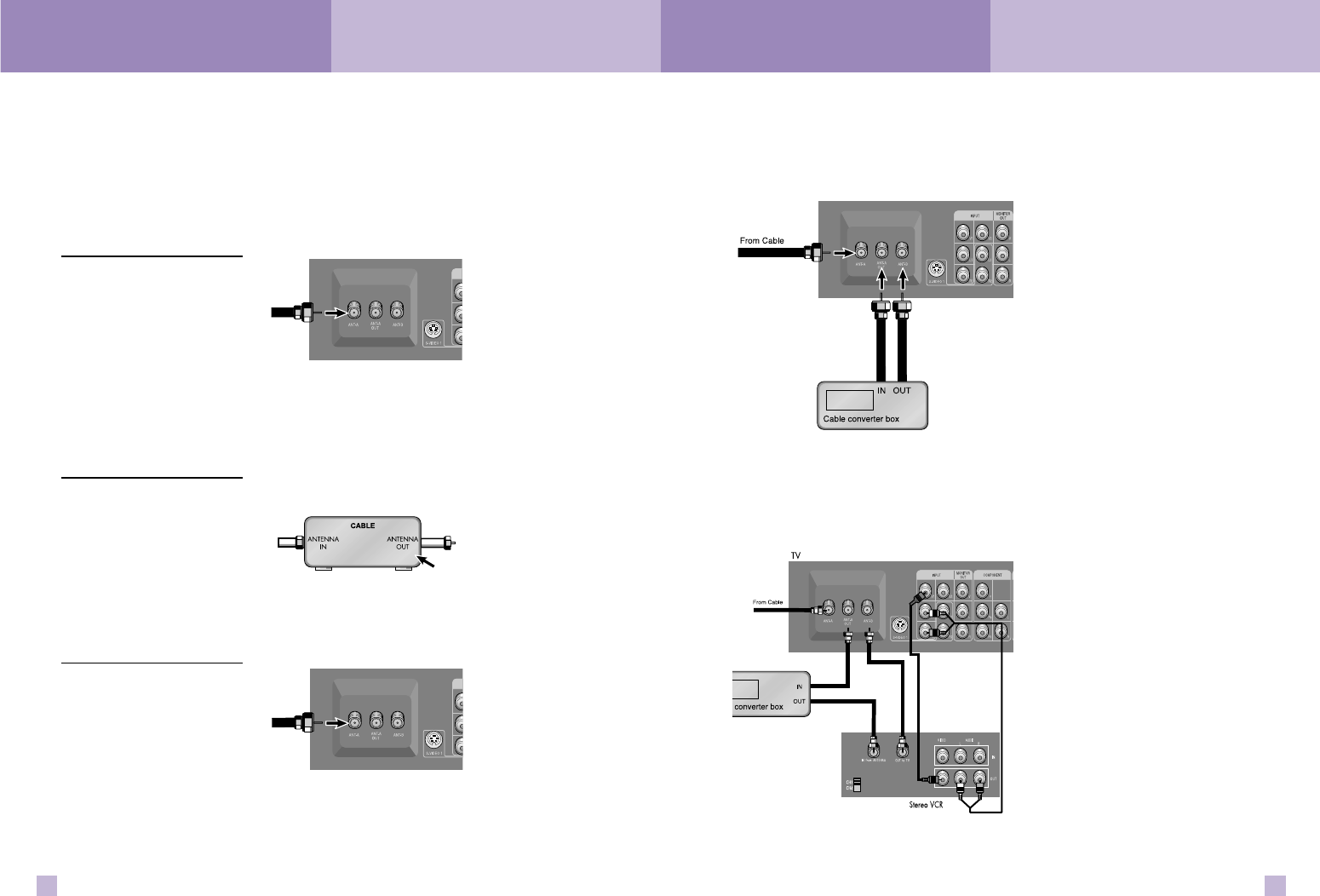
Connections Connections
20 21
Connecting Cable TV and VCR
You can connect different cable systems to your TV, including cable without a cable box, and
cable with a cable box that descrambles some or all channels.
Cable without a Cable Box
If you want to connect cable, and you do not need to use a cable box:
1Plug the incoming cable
into the ANT A antenna
terminal on the back of the
TV.
Cable with a Cable Box that Descrambles All Channels
1Find the cable that is con-
nected to the ANTENNA
OUT terminal on your
cable box. This terminal
might be labeled “ANT
OUT,” “VHF OUT,” or sim-
ply, “OUT.”
2Connect the other end of
this cable to the ANT A
antenna terminal on the
back of the TV.
Connecting a Cable Converter Box
This connection allows you to watch cable and premium channels. You should keep your TV
selected to ANT A so that you can use the TV features. When viewing premium channels, select
ANT B and tune the TV to channel 3 or 4 (whichever channel is vacant in your area), then use the
converter box to change channels. You will need two coaxial cables.
Note: When you use a converter box with
your TV, there may be features that you can
not program using the remote control, such as
programming your favorite channels and block-
ing channels.
Connecting a Cable Converter Box and a VCR
This connection allows you to watch and record basic and premium cable channels, as well as
watch videotapes. You should keep your TV selected to ANT A so that you can use the TV’s fea-
tures. When viewing premium channels or recording with the VCR, select ANT B (whichever chan-
nel is vacant in your area), then use the converter box to change channels.
Caution: If you want to record one channel
while watching another channel, a splitter (not
included) must be added between the cable
and ANT A. One output of the splitter goes to
ANT A and the second output is connected to
IN on the cable converter box.
If you have a mono VCR, connect L/Mono to
VCR Audio OUT using only one audio cable.
If you have a S-VHS VCR, use the S-video con-
nections and remove the video cable. Do not
connect the video cable and the S-video cable
to video1 simultaneously.
When you use a converter box with your TV
there may be features that you can not pro-
gram using the remote control, such as pro-
gramming your favorite channels and blocking
channels.
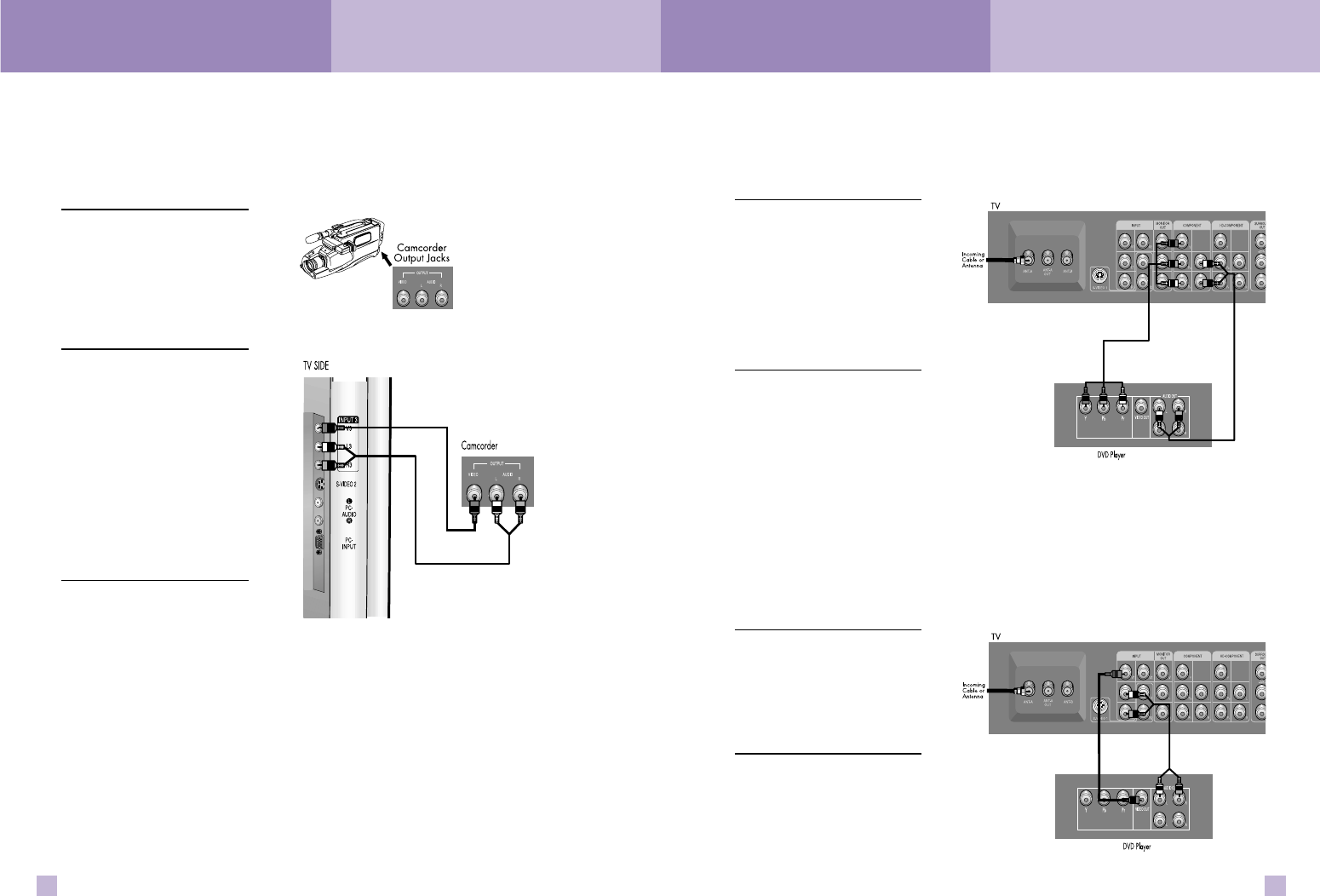
Connections
23
Connections
22
Connecting a Camcorder
The side panel jacks on your TV make it easy to connect a camcorder to your TV. You can
use your camcorder to view tapes without using a VCR.
1Locate the A/V output jacks
on the camcorder. They are
usually found on the side or
back of the camcorder.
2Connect an audio cable
between the AUDIO OUT-
PUT jack on the camcorder
and the AUDIO terminals
on the side of the TV.
If your camcorder is stereo,
you must connect two sepa-
rate cables.
(The audio cables are usu-
ally included with the cam-
corder.)
3Connect a video cable
between the VIDEO OUT-
PUT jack on the camcorder
and the VIDEO terminal on
the side of the TV. (A video
cable is usually included
with the camcorder.) To
watch a tape, follow your
camera’s instructions and
the section on “Viewing a
VCR, DVD or Camcorder
Tape” in this manual.
Connecting a DVD Player
The rear panel jacks on your TV make it easy to connect a DVD player to your TV.
Connecting to Y,PB,PR
1Connect a set of audio
cables between the
Component audio in jacks
on the TV and the AUDIO
OUT jacks on the DVD play-
er.
2To enable Component
video viewing, connect
video cables between the Y,
PBand PRinputs on the TV
and Y, PBand PR(or Y, CB,
CR) outputs on the DVD
player.
Note: For an explanation of
Component video, see your
DVD player's owner's man-
ual.
Connecting to audio and video jacks
1Connect a set of audio
cables between the Audio
in jacks on the TV and the
AUDIO IN jacks on the
DVD player.
2Connect video cables
between the VIDEO OUT
jack on the DVD player and
the VIDEO IN jack on the
TV.
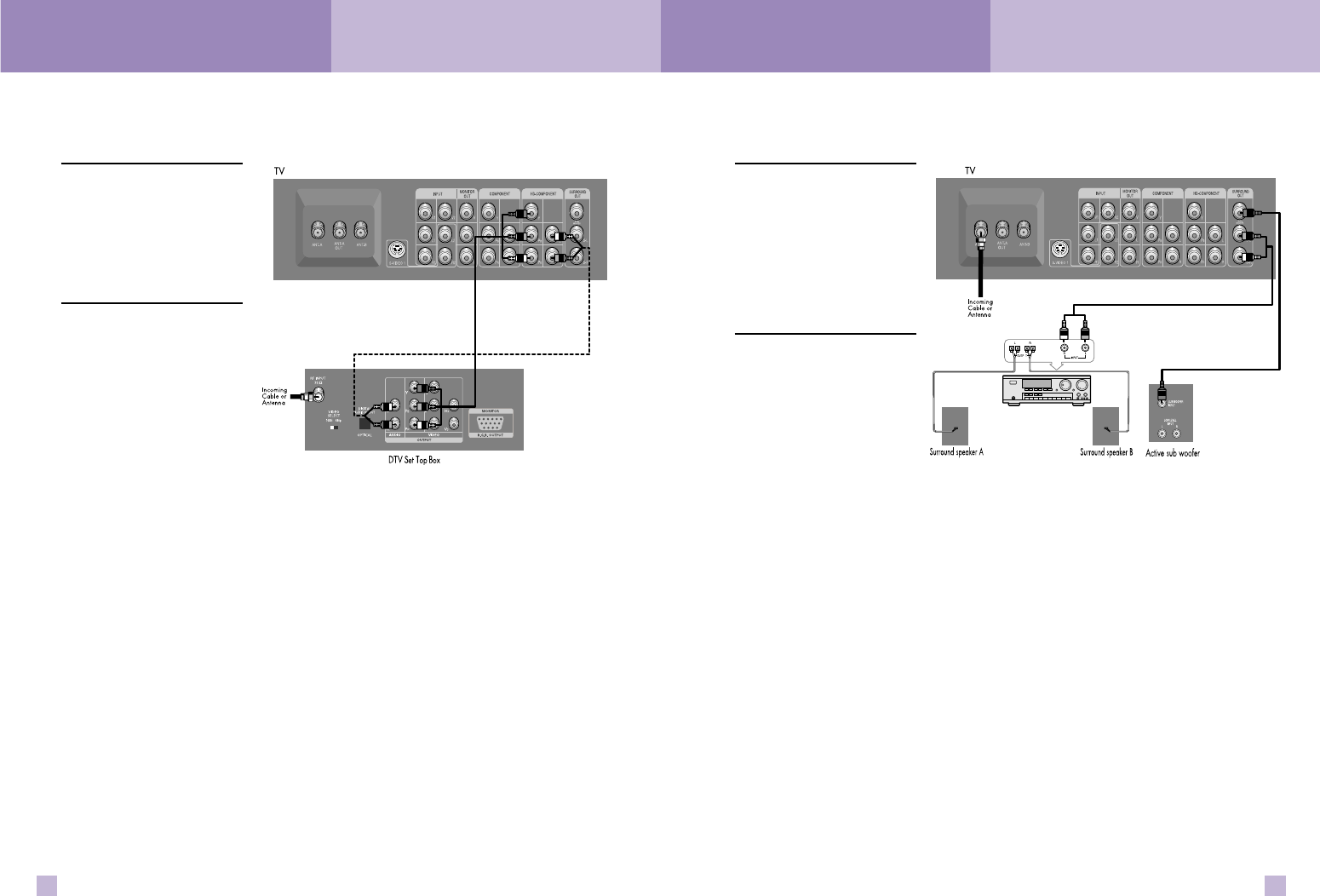
25
Connections
24
Connections
Connecting a DTV Set Top Box
1Connect AUDIO outputs of
the Set Top Box to the HD-
COMPONENT AUDIO L/R
input of the TV.
2Connect Y/PB/PR (or Y, CB,
CR) jacks of the Set Top
Box to the HD-COMPO-
NENT Y/Pb/Pr jacks of
the TV.
Note: The DTV Set-Top-Box connection is not supported in PC mode.
Connecting Surround Speakers
1Connect inputs of an
amplifier to the SUR-
ROUND OUT outputs of
the TV.
Then connect the surround
speakers to your amp.
2Connect the subwoofer
input on the active sub-
woofer to the subwoofer
jack on the rear of the TV.
Note: Use a subwoofer
with a built-in amp.

Operation
SAMSUNG
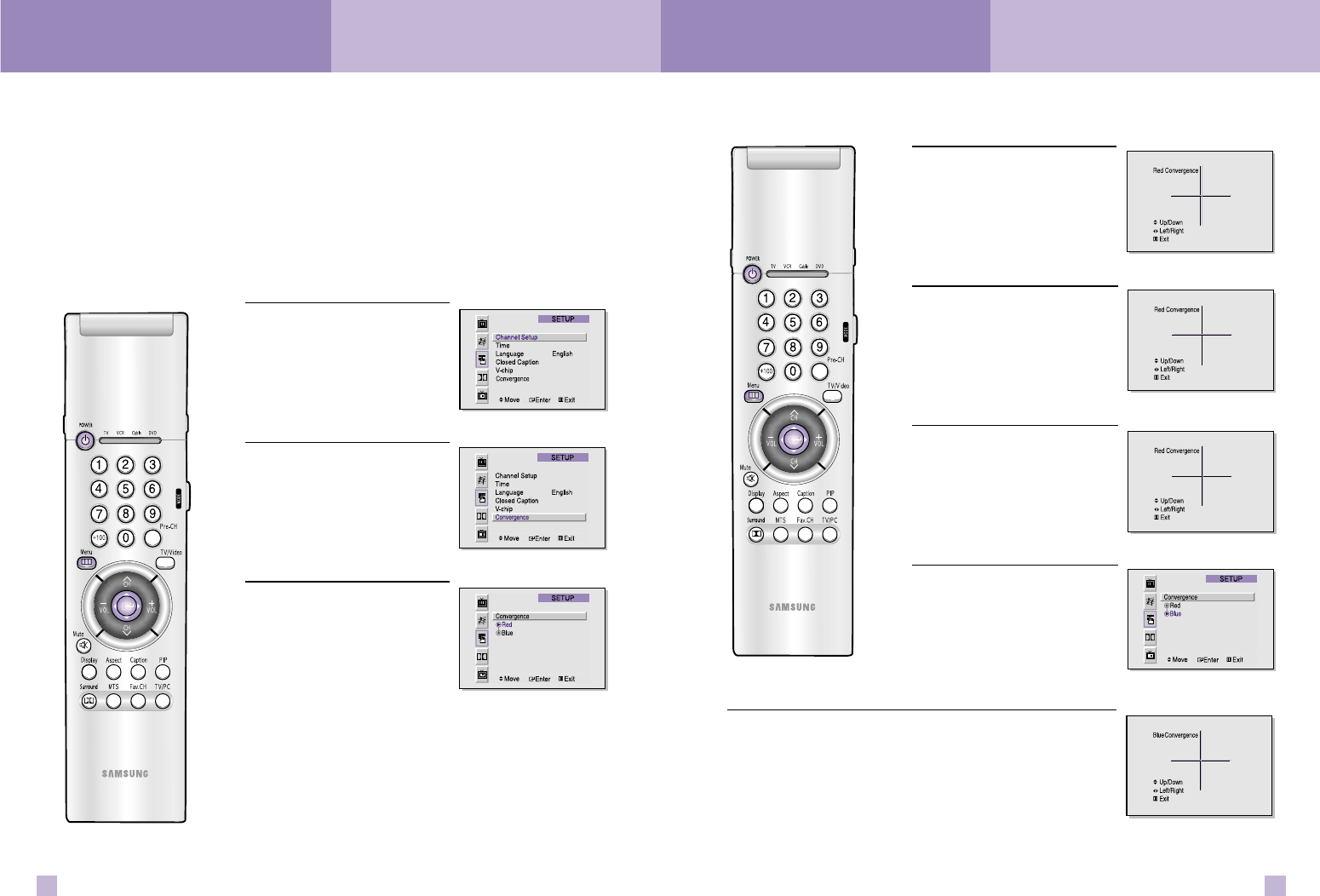
Adjust Red Convergence
4While “Red” is highlighted,
press the joystick to enter.
A crosshair pattern will appear
on the screen.
If either a vertical or a
horizontal red line is visible,
then the convergence needs
alignment.
5If a horizontal red line is visi-
ble, move the joystick up and
down to move the line so that
is superimposed on the hori-
zontal center-line (i.e., make a
single horizontal line that is as
white as possible.)
6If a vertical red line is visible,
move the joystick right and left
to move the line so that it is
superimposed on the vertical-
center line (i.e., make a single
vertical line that is as white as
possible.)
7At this point, the Red conver-
gence is correctly adjusted.
Press Menu, then move the
joystick down to select “Blue”.
Adjust Blue Convergence
8While the word “Blue” is highlighted, move the joystick to enter.
When the crosshair pattern appears, move the joystick to con-
vergence the blue line (same procedure as in steps 1~7,
above).
After the blue convergence is correctly adjusted, press Menu to
exit menu.
NOTE
Some flashes may appear on the screen during the convergence adjustments.
This does not indicate a problem and is normal.
29
Operation
28
Turning the TV On and Off
Press the Power button on the remote control or on the side panel to turn your TV on and off.
Adjusting Basic Convergence
If the color appears spread out or “smeared” on the screen, the convergence probably needs align-
ment. Be sure to use the remote control for the convergence adjustments.
First steps: 1With the power on, press the
Menu button on the remote
control. Move the joystick
down to select SETUP, then
press the joystick to enter.
2Move the joystick down to
select “Convergence”, then
press the joystick to enter.
3The “Convergence” screen will
appear, and the word “Red”
will be highlighted.
Operation
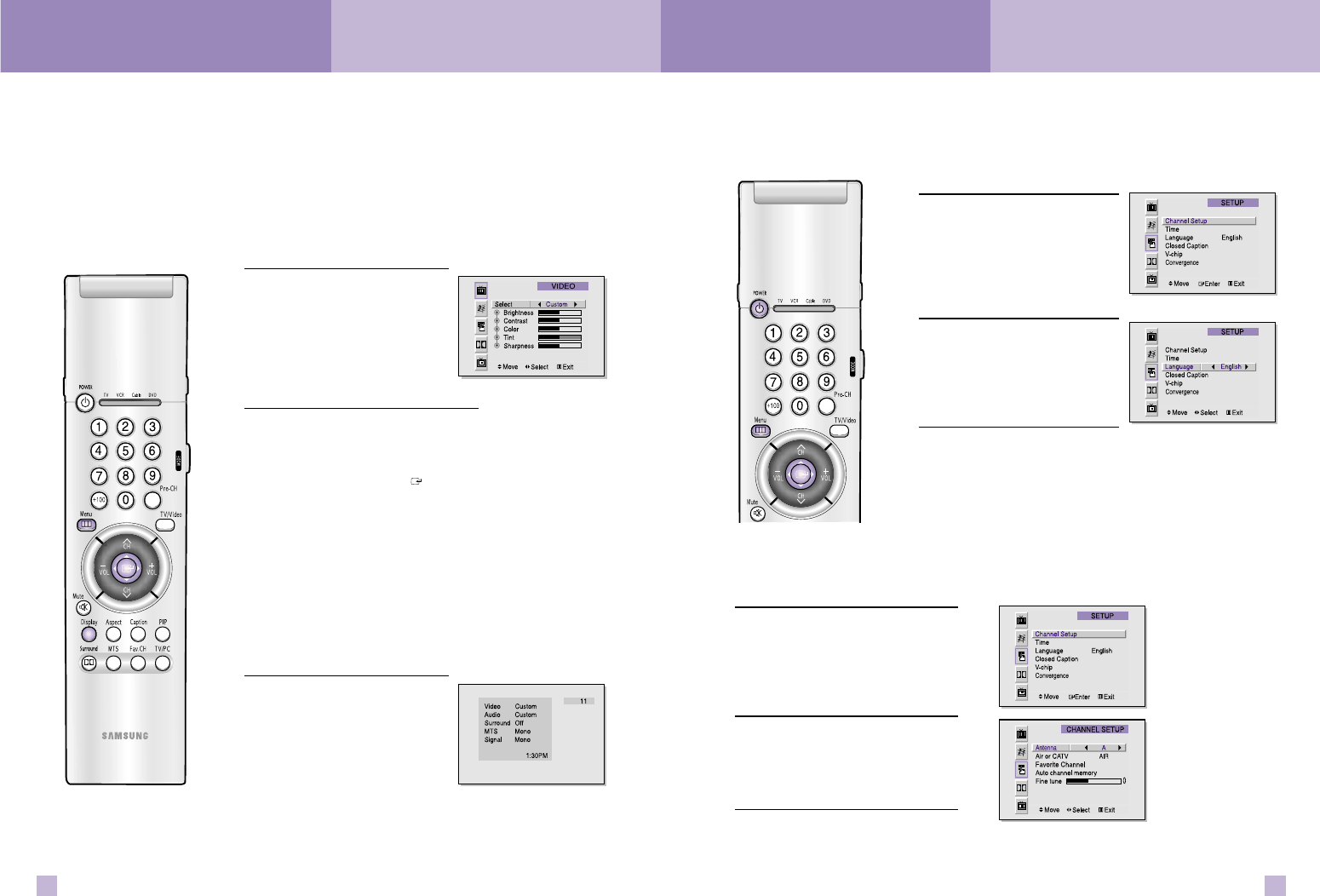
Selecting the Menu Language
Choose a language for the on-screen menus: English, Spanish or French.
1Press the Menu button.
Move the joystick down to
select SETUP, then press the
joystick to enter.
2Move the joystick down to
select ”Language.”
3Move the joystick right or left
to select the language.
Press the Menu button on the
remote control to exit the
menu.
Selecting the Antenna Input
You can connect to two different signal sources by choosing the antenna input(ANT A or ANT B).
1Press the Menu button.
Move the joystick down to select
SETUP, then press the joystick to
enter.
2Press the joystick to enter. The
channel setup menu will appear.
The first line of the menu is select-
ed.
3Move the joystick right or left to
select “ANT A” or “ANT B”.
Press the Menu button on the
remote control to exit the menu.
Operation Operation
30 31
Viewing the Menus and Displays
The on-screen menu system allows you to control the settings of your TV. Access the on-screen menu
system by pressing the Menu button on the remote control. Once the on-screen menu appears, use
the joystick button on your remote control to move between menu items, select menu items, and
make adjustments. You can also view the on-screen menu system and make some adjustments using
the TV’s side panel buttons.
Displaying the Menus 1With the power on, press the
Menu button on the remote
control. The main menu
appears on the screen. The
Video menu is selected.
2Use the joystick (up, down) button
to move to items in the menu. Use
the joystick (left, right) button to dis-
play, change, or use the selected
items. Use the joystick ( ) button
to enter items in the menu. On-
screen menus disappear from the
screen automatically after about
thirty seconds, or you can press the
Menu button on your remote control
to exit the menu.
Displaying Status Information
1Press the Display button on the
remote control. The TV will dis-
play the channel, current time,
and the audio signal you are
listening to.
NOTE
When the cable box output is connected to
ANT-B, it cannot be viewed in the PIP win-
dow.
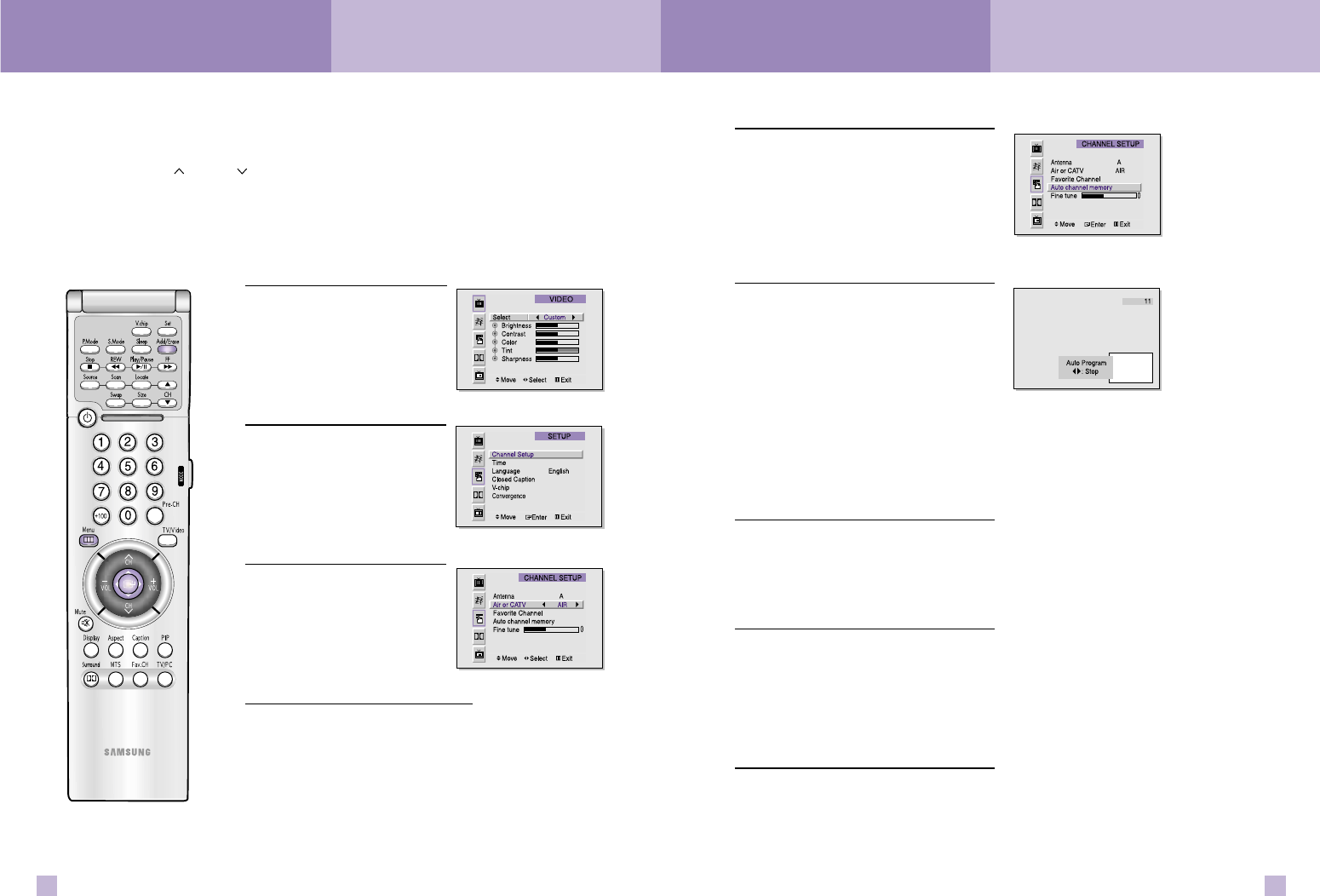
Operation Operation
32 33
Channel Memory
Your TV can memorize and store all of the channels available. Once the channels are memorized,
you can use the CH and CH buttons to scan through the available channels.
Selecting the Broadcast Source
Before memorizing available channels, you must select what broadcast source your TV is connect-
ed to, either an antenna or a cable system.
1Press the Menu button on the
remote control to display the
on-screen menu.
2Move the joystick down to
select SETUP, then press
the joystick to enter.
3Press the joystick to enter. The
channel setup menu will
appear. Move the joystick
down to select “Air or CATV”.
4If you are connected to an anten-
na, leave “AIR” displayed. If you
connected cable, press the joystick
to the right to display the type of
cable system: “STD,” “HRC,” or
“IRC.” (If you are not sure which
type of cable system you have,
contact your cable company.)
Storing Channels in Memory Automatically
1First, select the broadcast source as
described on the previous page. With
the CHANNEL SETUP menu on screen,
move the joystick down to select “Auto
channel memory.”
2Press the joystick to enter. The TV will
begin memorizing all of the available
stations. Move joystick right or left at
any time to interrupt the memorization
process.
If the TV set stops operation when AUTO
PROGRAM runs, it is recommended to
re-run the program.
Note: When the ANT B mode is selected, the auto programming
runs on the main screen.
Adding and Erasing Channels
1Use the number buttons to select the
channel you want to add or erase.
2To add a channel, select it and press the
Add/Erase button on the remote control.
The channel will be added to the TV’s
memory and the word “Add” will
appear in the corner of the screen.
3To erase a channel, select it and then
press the Add/Erase button on the
remote control. The word “Erase” will
appear in the corner of the screen. You
can still view a channel that has been
erased from memory by using the num-
ber buttons on the remote control to
select the channel directly.
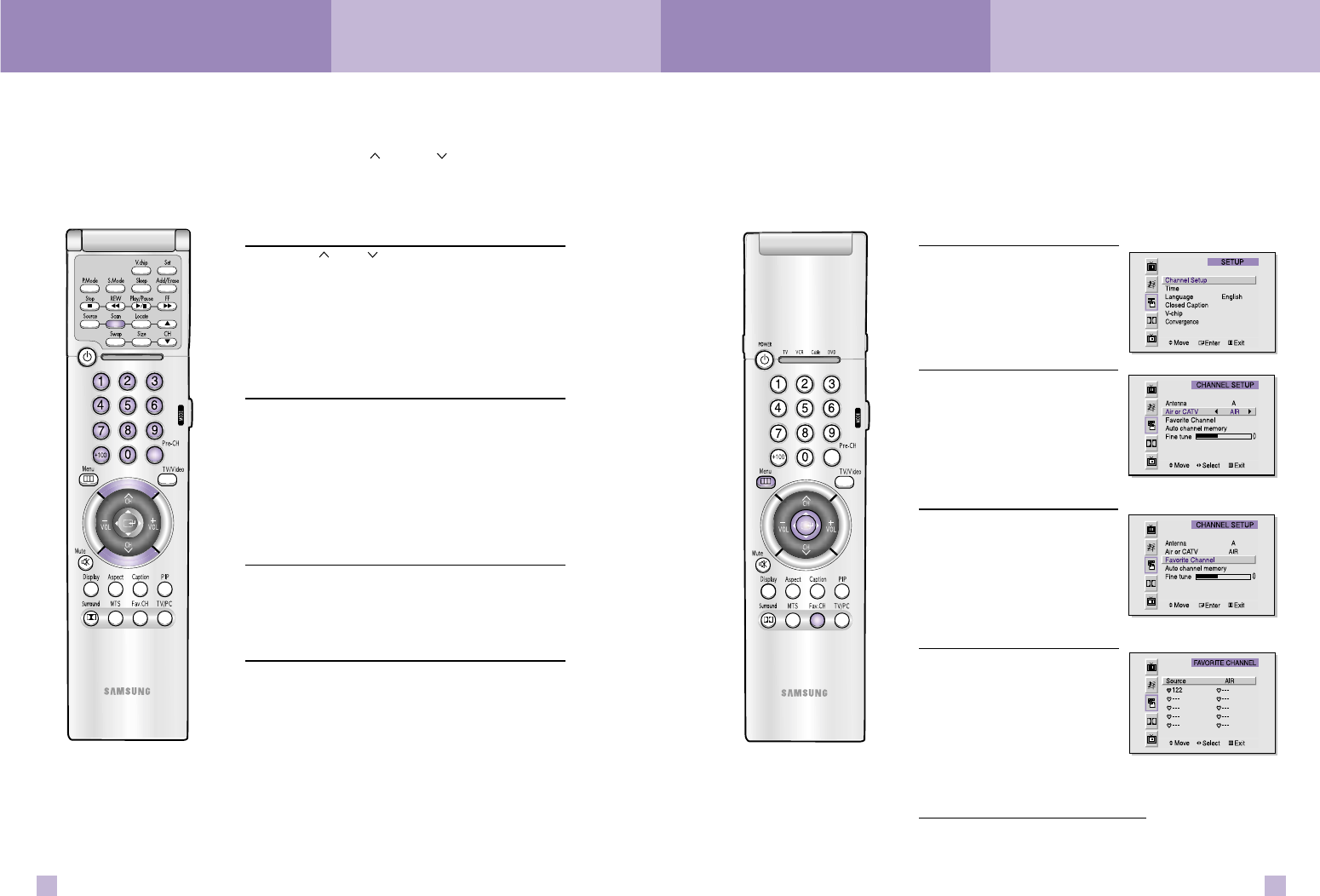
Selecting Your Favorite Channels
You can store up to ten of your favorite channels for each available input source (such as TV and
CATV). Then, when you press the Fav.CH button on the remote control, the TV displays only the
favorite channels you previously stored, allowing you to quickly and easily find frequently
watched channels.
To Store Your Favorite Channels:
1Press the Menu button. Move
the joystick down to select
SETUP, then press the joystick
to enter.
2Press the joystick to enter.
The channel setup menu will
appear. Move the joystick
down to select Air or CATV,
then move the joystick to
the right to display the type of
cable system or Air.
3Move the joystick down to
select “Favorite Channel”,
then press the joystick to
enter.
4Move the joystick to the left or
right to select channel.
Note: Only memorized chan-
nels can be set as Favorite
channels.
To View Your Favorite Channels:
Press the Fav.CH button repeatedly to
jump from one favorite channel
to another.
Operation Operation
34 35
Changing Channels
You can change channels on your TV by using the CH and CH buttons, or by direct selec-
tion using the number buttons. You can use the number buttons to tune to any channel (even one
that has been erased or has not been memorized).
Using the Channel Buttons
Press the CH or CH buttons to change channels. The
TV changes each channel in order, up or down, depend-
ing on which button you press. You will see all the chan-
nels that the TV has memorized. (The TV must have mem-
orized at least three channels.) You will not see channels
that were not memorized or have been erased.
Using the Number Buttons
To change to single-digit channels (0–9) faster, press “0”
before the single digit.
Example: For channel 4, press “0,” then “4.”
To select a channel over 100, press the +100 button
first.
Example: For channel 122, press “+100,” then “2,” then “2.”
Using the Previous Channel
Press the Pre-ch button on the remote control. The TV
changes to the last channel you were watching.
Scanning channels
You can automatically scan all of the channels in memo-
ry at the touch of just one button. Press the Scan button
on the remote control. The TV will change the channels
automatically, one by one. To stop channel scan,
press the Scan button again.
Note: When the ANT B mode is selected, the chan-nels
scan function doesn’t work.
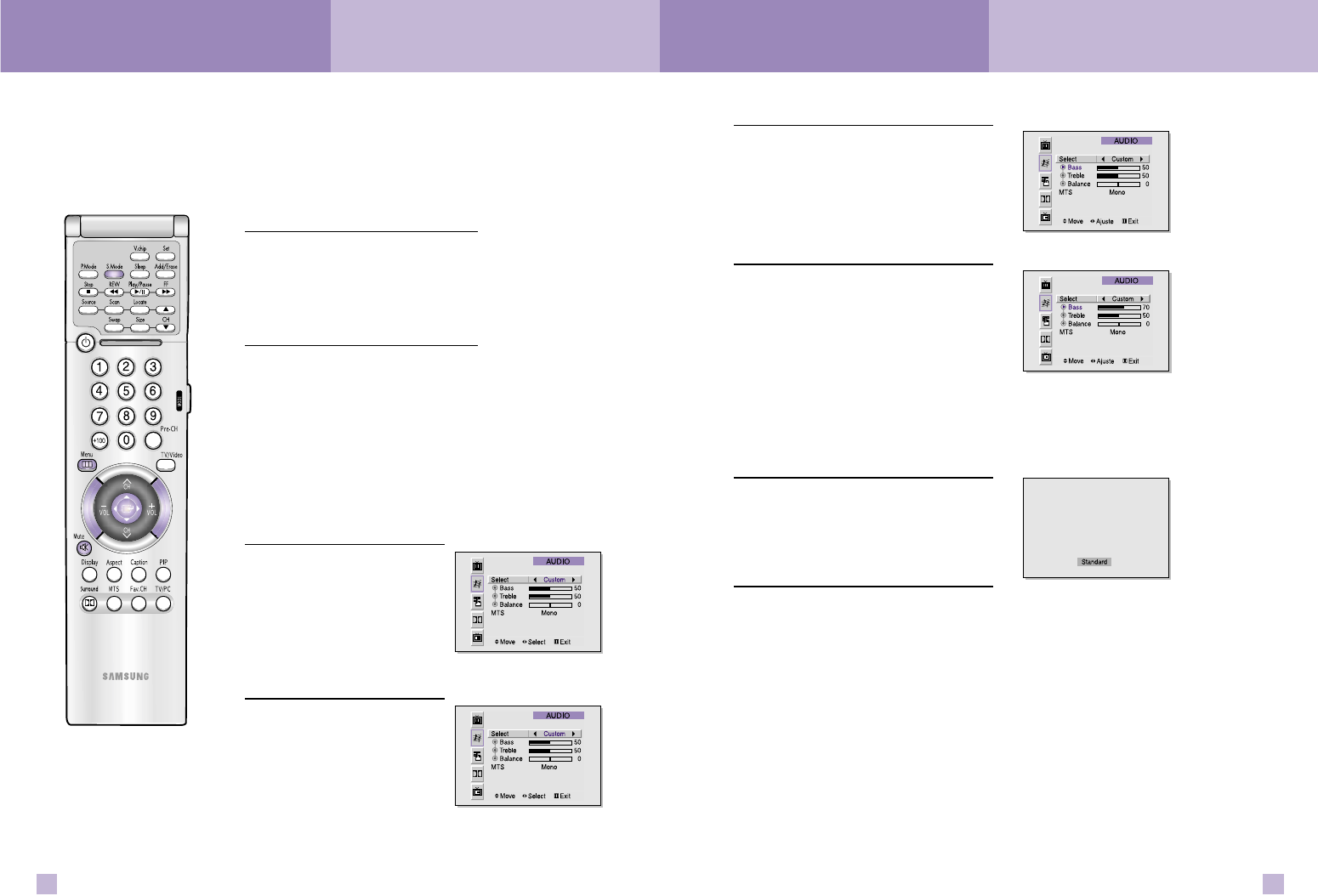
3Move the joystick down to select the item
you want to change.
4Move the joystick right or left to raise or
lower the value of the item, using the on-
screen gauge as your guide.
You can continue to make adjustments, or press the Menu button to exit.
Using Automatic(Standard) Sound Settings
1Press the S.Mode button on the remote
control to change the automatic sound
setting.
2Press the S.Mode button again to select
the “Standard,” “Music,” “Movie,”
“Speech,” or “Custom” sound setting.
Guide to Automatic Sound Settings
• Choose Standard for the “factory” settings (the best choice for most people).
• Choose Music when watching music videos or concerts.
• Choose Movie when watching a movie.
• Choose Speech when watching a show that is mostly dialogue, like a news show.
• Choose Custom if you want to adjust the settings yourself.
37
Operation
36
Sound Control
You can control and customize the sound levels and settings of the TV with the remote control.
Using the on-screen menus, you can change the TV’s bass, treble, and balance settings.
Adjusting the Volume
Press VOL + to raise the volume or
VOL –to lower the volume.
Using the Mute Button
Press the Mute button on the remote con-
trol to silence the volume. The word
“Mute” will appear in the lower left cor-
ner of the screen.
To turn mute off, press the Mute button
again, or raise or lower the volume with
the VOL – and VOL + buttons.
Customizing the Sound
1Press the Menu button on the
remote control to display the
on-screen menu. Move the joy-
stick down to select the
AUDIO menu. Press the joy-
stick to enter.
2You will see the items “Bass,”
“Treble,” “Balance,” and
“MTS.”
Continued...
Operation
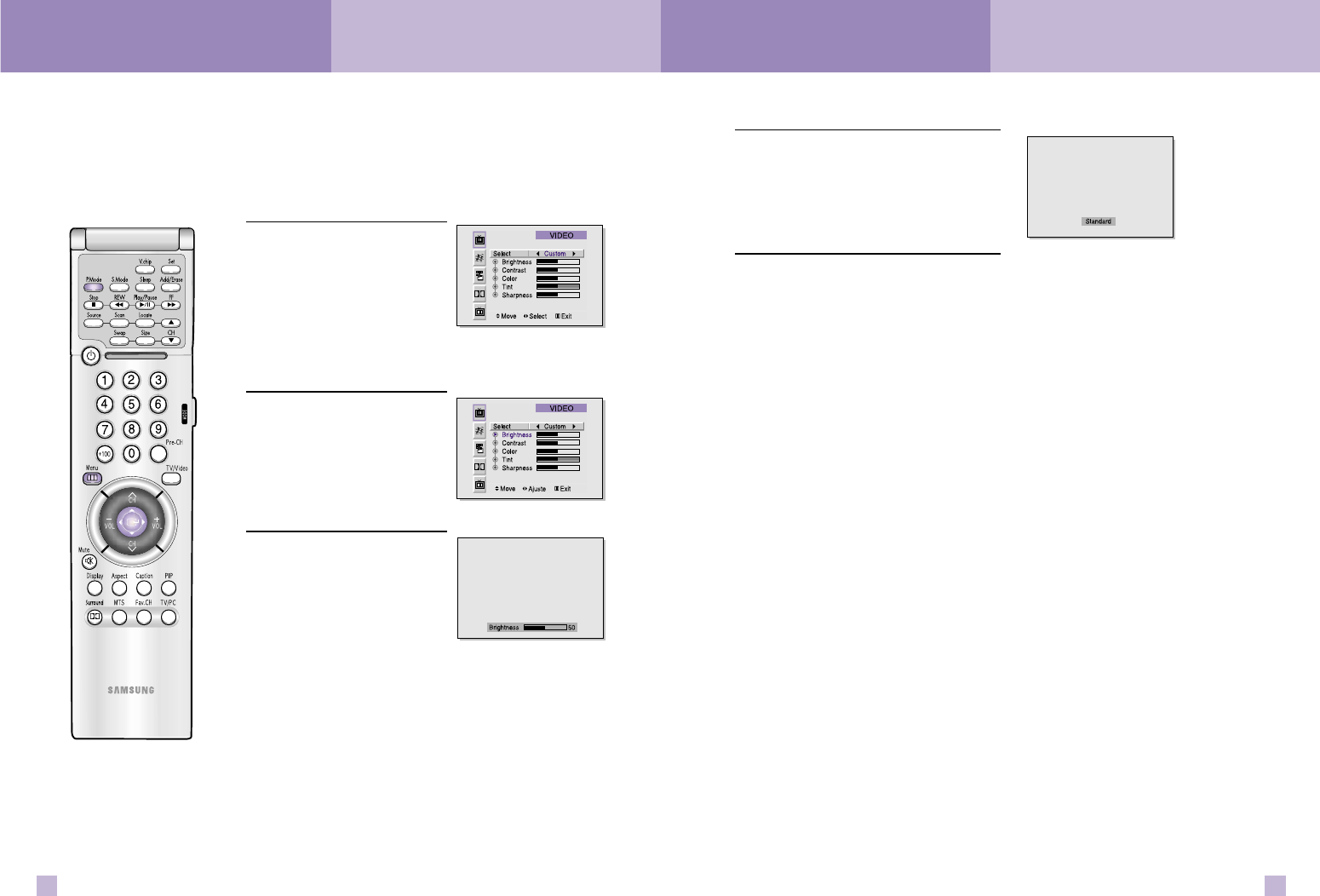
Using Automatic (“Standard”) Picture Settings
1 Press the P.Mode button on the remote
control to change the picture settings.
2Press P.Mode repeatedly to select the
“Standard,” “Mild,” or “Custom” picture
setting.
Guide to Automatic Picture Settings
• Choose Standard to set the TV to operate at top performance according to your TV’s
specifications.
• Choose Mild when viewing the TV in low light, or when playing video games.
• Choose Custom if you want to adjust the settings yourself.
Picture Control
Using the remote, you can change the contrast, brightness, tint, color, and sharpness settings of
the TV.
Customizing the Picture
1Press the Menu button.
Press the joystick to enter.
Move joystick left or right to
select “Custom”.
You will see the items
“Brightness,” “Contrast,”
“Color,” “Tint,” and
“Sharpness.”
2Move the joystick down to
select the item you want to
change.
3Move the joystick right or left
to raise or lower the value of
the item.
When you are finished adjusting an item, wait a moment. The
level indicator will disappear and the Video menu will return.
You can continue to make adjustments, or press the Menu button
to exit.
39
Operation
38
Operation